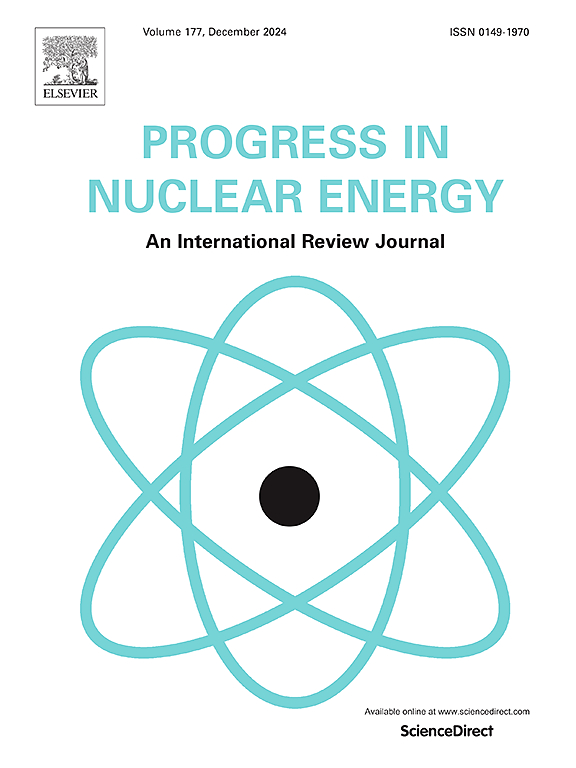Research on leakage and migration behavior of 87Kr/135mXe in the Molten Salt Reactor containment
IF 3.3
3区 工程技术
Q1 NUCLEAR SCIENCE & TECHNOLOGY
引用次数: 0
Abstract
Effective monitoring and control of radioactive gas leakage are crucial for the safe operation of Molten Salt Reactors (MSRs). The liquid fuel in MSRs increases the mobility of radioactive materials. Therefore, predicting the migration and leakage of volatile radioactive products from primary system boundaries is essential. This study, for the first time, focuses on the migration behavior of radioactive gases within the MSR containment during the first 2 h following the appearance of small leaks. Using the FLUENT software, the research investigates the influence of gas flow fields, leakage locations, and decay characteristics on the transport of these radioactive gases, particularly 87Kr and 135mXe. The results indicate that pre-existing gas flow fields significantly affect the distribution and migration of radioactive gases, leading to a more uniform concentration distribution. Furthermore, the concentration ratios of 87Kr to 135mXe exhibit a near-linear increase with leakage time, with the specific magnitude of increase being strongly correlated with leakage locations. When the initial leaking concentration ratio of 87Kr to 135mXe is set at approximately 1.70, the concentration ratios for leakage locations (i.e., point 1, point 2, and point 3) increase to 1.81, 1.86, and 1.89 at 3 min after leakage, and to 5.90, 6.80, and 7.94 at 2 h after leakage, respectively. This study proposes a novel monitoring approach based on the concentration and concentration ratios of 87Kr and 135mXe for MSRs. This approach provides valuable information for leakage diagnosis, such as leakage time, location, and flow rate, and offers technical support for the radiation monitoring and safe operation of MSRs.
熔盐堆安全壳87Kr/135mXe泄漏与迁移行为研究
有效监测和控制放射性气体泄漏对熔盐堆的安全运行至关重要。msr中的液体燃料增加了放射性物质的流动性。因此,预测挥发性放射性产物从初级系统边界的迁移和泄漏是至关重要的。本研究首次将重点放在小泄漏出现后的头2小时内放射性气体在MSR安全壳内的迁移行为上。利用FLUENT软件,研究了气体流场、泄漏位置和衰变特性对这些放射性气体输运的影响,特别是87Kr和135mXe。结果表明,预先存在的气体流场显著影响放射性气体的分布和迁移,导致放射性气体浓度分布更加均匀。87Kr / 135mXe的浓度比随泄漏时间呈近线性增长,具体增长幅度与泄漏位置密切相关。当87Kr与135mXe的初始泄漏浓度比约为1.70时,泄漏位置(即点1、点2和点3)的浓度比在泄漏后3 min分别增加到1.81、1.86和1.89,在泄漏后2 h分别增加到5.90、6.80和7.94。本研究提出了一种基于87Kr和135mXe浓度和浓度比的MSRs监测新方法。该方法为泄漏时间、泄漏位置、泄漏流量等泄漏诊断提供了有价值的信息,为核反应堆的辐射监测和安全运行提供了技术支持。
本文章由计算机程序翻译,如有差异,请以英文原文为准。
求助全文
约1分钟内获得全文
求助全文
来源期刊

Progress in Nuclear Energy
工程技术-核科学技术
CiteScore
5.30
自引率
14.80%
发文量
331
审稿时长
3.5 months
期刊介绍:
Progress in Nuclear Energy is an international review journal covering all aspects of nuclear science and engineering. In keeping with the maturity of nuclear power, articles on safety, siting and environmental problems are encouraged, as are those associated with economics and fuel management. However, basic physics and engineering will remain an important aspect of the editorial policy. Articles published are either of a review nature or present new material in more depth. They are aimed at researchers and technically-oriented managers working in the nuclear energy field.
Please note the following:
1) PNE seeks high quality research papers which are medium to long in length. Short research papers should be submitted to the journal Annals in Nuclear Energy.
2) PNE reserves the right to reject papers which are based solely on routine application of computer codes used to produce reactor designs or explain existing reactor phenomena. Such papers, although worthy, are best left as laboratory reports whereas Progress in Nuclear Energy seeks papers of originality, which are archival in nature, in the fields of mathematical and experimental nuclear technology, including fission, fusion (blanket physics, radiation damage), safety, materials aspects, economics, etc.
3) Review papers, which may occasionally be invited, are particularly sought by the journal in these fields.
 求助内容:
求助内容: 应助结果提醒方式:
应助结果提醒方式:


